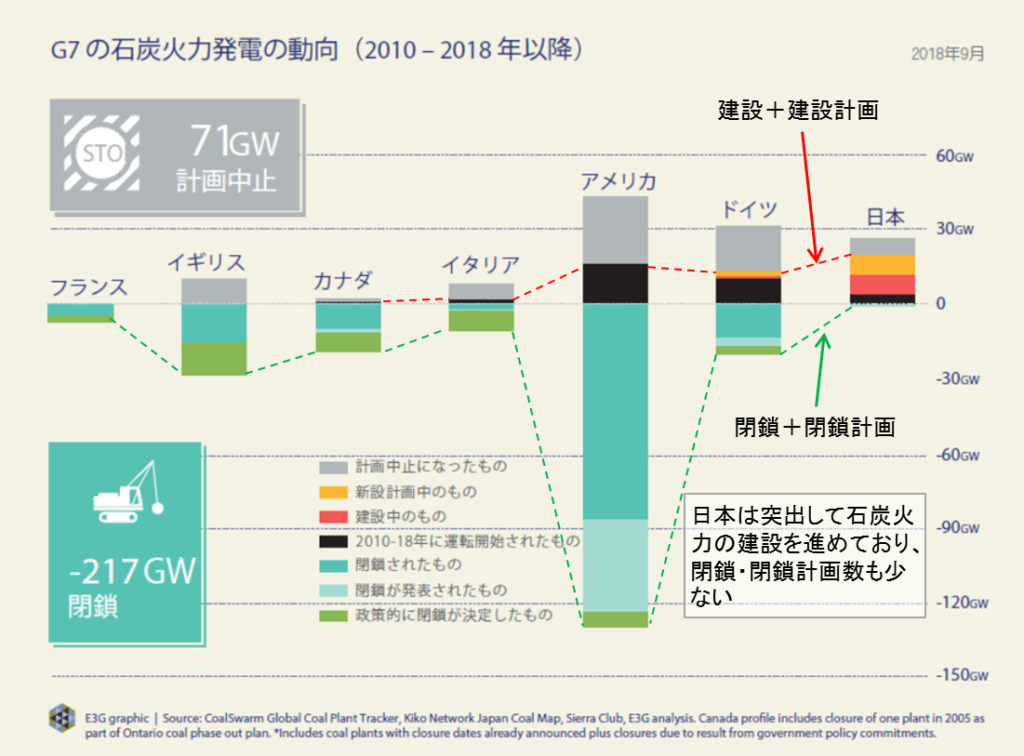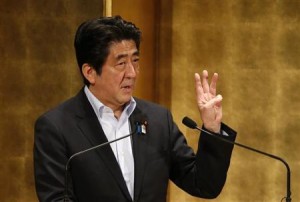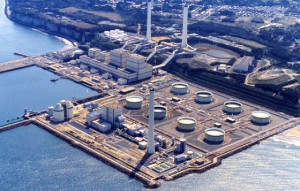[:ja]4.石炭火力をめぐる世界の事情
「パリ協定」で変わる世界
人類の生存を脅かす気候変動問題。人間が排出してきた温室効果ガスによって、地球の気温があがり、海面上昇、干ばつ、集中豪雨、氷河の融解、異常気象の多発といった気候変動を引き起こしています。
2015年11月、「パリ協定」が採択され、地球の気温上昇を1.5℃から2℃未満に抑えるために、世界全体の温室効果ガスの排出量を劇的に削減し、今世紀半ばには実質ゼロにすることが求められています。パリ協定に基づき、今、世界は、化石燃料を燃やさない時代、脱炭素社会をめざしはじめたのです。世界的に、再生可能エネルギーへの転換が進んだり、石炭火力発電所を廃止する動きが強まったりしています。
新たな火力発電所を建設をすることは、気温上昇を1.5℃未満という目標達成を危うくするばかりか、3℃、4℃と気温を上昇させることにもつながり、将来世代に対して大きな負の遺産を遺すことになるでしょう。
「脱石炭火力」を宣言する国々
石炭火力発電所は、火力発電の中でも特にCO2の排出が最も大きいことから、最初に石炭火力から脱却を宣言する国や自治体などが増えています。例えば、イギリスでは2025年、フランスでは2021年、カナダでは2030年までに既存の石炭火力発電を止める宣言をしています。
2016年には、こうした国々がイニシアティブをとり、「脱石炭連名(PPCA)」が発足しました。52の国や自治体※が、遅くとも2030年までに石炭火力を廃止すること宣言しているのです。2018年には、アジアでもはじめて韓国の自治体、忠清南道(チュンチョンナムド)が、PPCAに加盟することを宣言しました。欧米の先進国だけではなく、お隣の中国や韓国でも、国内の石炭火力発電所は減らしていく方向で政策が打ち出されています。
※出典:Powering Past Coal Alliance 2018年12月現在
世界で始まる石炭産業からの投資撤退「ダイベストメント」
世界では、パリ協定をまもるため金融機関の動きも非常に活発になっています。化石燃料関連企業からの投資を引き揚げる、いわゆる「ダイベストメント」と言われる投資家や金融機関のアクションです。世界では、大手の銀行、保険会社なども率先して、石炭産業からの投資撤退をはじめています。ダイベストメントのキャンペーンを世界規模で行う環境NGO 350.orgの調べでは、ダイベストメントを行っている組織は1,025団体、個人は58,000人以上にものぼり、その運用総額は8,800兆円にもなります※。化石燃料関連から引き上げた資金は、自然エネルギーの方に振り向けられているのです。
※出典:FOSSILE FREE 2018年12月現在、1$=111円で計算
日本だけが逆行している!
このような世界の状況をみると、いかに世界の中で日本だけがとり残された状況であるかがわかると思います。下のグラフのように、石炭火力発電をめぐるG7の状況を比較してみると、アメリカを筆頭に欧米諸国は国内の石炭火力の閉鎖や閉鎖を公表しているところなどが多くみられる一方、新規に建設をはじめたり、計画したりしているものが少ないことがわかり、日本だけが突出して石炭火力を推進している状況が浮き彫りになります。 <G7の石炭火力発電の動向(2010-2018以降)>
<G7の石炭火力発電の動向(2010-2018以降)>
[:en]4.Recent movements
(Updated June 12th, 2014)
Under Japanese Prime Minister Abe’s administration (from December, 2012), there has been a lot of momentum towards the utilization of coal as an energy source.
1.Japanese government’s policies

PM Shinzo Abe (Source:Reuters/ Toru Hanai)
(1)Regulatory reform that facilities the construction of coal-fired power plants
In a governmental regulatory reform meeting in June 2013, it was reported that in order to boost the economy, environmental assessments for coal-fired thermal power plants became more straight-forward and conducted at a faster rate. Proposed power plants that would have taken 3 years to replace in the past, will now take only 1 year or so. The reason for this appears to be “that companies were having a difficulty in planning projects as the current environmental requirement to reduce CO2 is too stringent” and “as a result of that, it blocks new players that can provide a cheaper, more stable supply of energy from joining the market”. These concerns were raised because the Minister of the Environment had stated that construction of new coal-fired power plants will be problematic because of the restrictions on CO2 emissions in the environmental impact assessment, making it difficult to plan coal projects. Therefore, concerns were thrown out the window and the environmental assessment period was shortened and the process was simplified.
(2)“Japan’s Revitalization Strategy” – promoting coal-fired power plants
“Japan Revitalization Strategy” was announced in June 2013 as part of Prime Minister Abe’s broader ‘Abenomics’ program which was created to boost the Japanese economy. In this strategy, based on the regulatory reform proposal mentioned above, the government announced that they will promote the speeding up of the environmental assessment process in addition to making it more straight forward. This policy shortens the environmental impact assessment process from 3 years to just 1 year for coal-fired power plant replacements on the condition that it is in line with domestic GHG emission reduction targets and utilizes the best available technology (BAT).
It also states that, “clean coal technology” for coal-fired power plants, such as advanced ultra-supercritical (A-USC) technology, integrated gasification combined cycle (IGCC) and integrated coal gasification fuel cell combined cycle (IGFC), will be commercialized in 10 to 20 years’ time.
In addition, this strategy promotes the export of coal-fired power generation technology which, according to the proposal, will contribute to the economic development of developing countries as well as help reduce their greenhouse gas emissions.
In other words, under the government’s current policies, it has become easier and faster to construct coal-fired power plants and “clean coal technology” will continue to be developed and exported.
However, if coal-fired power plants, both in Japan and abroad, are easy to build, large amounts of CO2 will be emitted over a long period which will only accelerate the negative effects of climate change. This is a step in the wrong direction. We must set stricter environmental assessment standards and limit our “clean coal technology” exports to developing countries.
2.Plans to build coal-fired power plants in Japan

TEPCO’s Hirono Power Plant(Source:TEPCO)
In 2013, 2 new coal plants started operations in 2013: Hirono No. 6 (600 MW) in Fukushima prefecture and Hitachinaka No. 2 (1,000 MW) in Ibaraki prefecture. Unfortunately, there are more coal-fired power plants set to be put in operation in the coming years. Following the nuclear disaster in Fukushima, at the end of 2012 the government becomes more active in shifting towards coal-fired thermal power projects, pushing forward the construction plans of new coal-fired power plants. The government and utility companies are not only moving forward with plans to build additional coal-fired power plants but also plans to replace existing ones. This means that after 2020, new coal-fired power plants will be built one-by-one, operating until approximately 2060. This puts a significant burden on the environment and future generations.
(1) 3 successful bidders of TEPCO’s bid plan to build 2 new coal-fired power plants
TEPCO opened up bidding for a total of 2,600MW of thermal power for their “base load” electricity in February, 2013. This was a first time that TEPCO applied the new bidding guidelines designed by the Agency of Natural Resources to reduce power generation costs after the Fukushima nuclear accident. When they opened their bid, TEPCO set the low ceiling price of 9.53 yen/kWh to purchase electricity, which made it clear to everyone that only coal-fired thermal power plants were eligible. (read more)
Chubu Electric Power Co., Inc., Nippon Steel & Sumitomo Metal Corporation and Electric Power Development Co., Ltd won the bid to construct a total of two new coal plants. It came to no surprise that both power plants set to be built by these companies will be coal-fired. By the end of December 2013, 2 new companies (Hitachinaka Generation and Kashima Power Company) had already been established. These power plants are expected to be online around 2019-2021 therefore they are not intended to fill the energy gap left by the current shutdown of nuclear power plants, but rather to provide us with energy for the future over a long period.
(2) Plans for 2 new coal-fired power plants in Fukushima
TEPCO announced in December 2013 that they are considering to build 2 new coal-fired power plants (with a total output of 1000MW) in disaster-stricken Fukushima.
Even with the utilization of state-of-the-art IGCC (integrated gasification combined cycle technology), emissions will only fall as much as 710g-CO2/kWh, approximately 30% short of EPA’s proposed standard of 500g-CO2/kWh. This 3 billion dollar project is projected to start operations by 2020 (read more).
If these plans are set in motion, the year of 2020 could mark a huge rise in coal power. We must do what we can to avoid this.
(3) Replacement of a coal-fired power plant in Takehara, Hiroshima
J-Power is planning to replace Takehara coal-fired power plant’s new No.1 unit (600 MW) in Hiroshima. Environmental impact assessments began in 2011 and have been moving at an exceptional pace. Because this is a replacement, the new rule by Prime Minster Abe for accelerating the environmental impact assessment process will be applied thereby moving forward the project at a much faster speed. (read more). [:]

